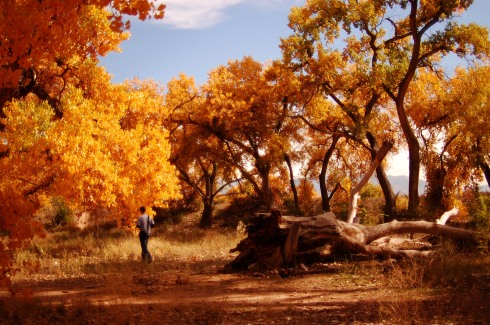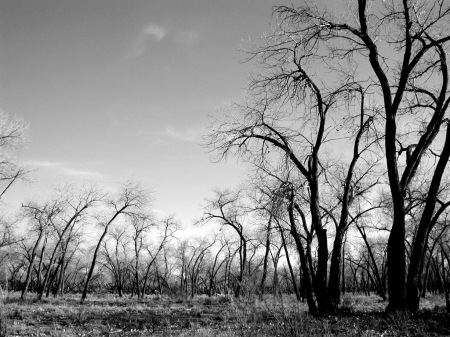Reposted from New Mexico Compass
By Alex Escué Limkin & Rebecca Limkin
—Summer 2018
I sit with my son on my lap overlooking a dusty depression, a swath of brown erosion bordered by thorny Russian olives and dense saltcedars. “What is this place?” my son asks me.
“We used to call this place the Bosque,” I reply. “I brought you here to help you imagine what this used to look like, and why we try so hard to protect the patches of wild nature that still remain.
Photo Credit: Driving in Heels via Compfight cc
“Before you were born, your mother and I would take walks here alongside the Rio Grande in the shade of the cottonwood trees. We would park just off of Tingley Drive or by the BioPark and wander into the woods. There were many small trails, and we were familiar with all of them.
“There were no cars here, no sirens, no machinery, no boardwalks, no asphalt. We could take off our shoes and cool our feet in the water on hot summer days and feel like we were in the middle of a wilderness—even with the road just a few hundred feet away. The parking lots didn’t intrude into the Bosque, and there were no paved paths, trash cans or restrooms alongside the river. This all used to be trees, and the trees were filled with wildlife.” I waved my arm behind us.
“There were hundreds of different water birds and other animals that sheltered here: migrating geese and ducks and cormorants and herons and egrets, not to mention beavers and porcupines, muskrats and fish.”
“What happened?” my son asks.
“A mayor called Berry thought that the Bosque was not being used enough, so he hired a team of advisers to come up with what they called ‘improvements.’ The team decided that by building parking lots and bridges, boat launches and restaurants, people would come and spend money here.
“The mayor believed people wanted convenience and entertainment from the Bosque, not wildness or to feel the natural world around them. He seemed to think that people were afraid of touching the earth with their bare feet.”
“Did it work?”
“On one hand it did. More people came in their cars to buy things, but it lasted only a short while.
“The very year the mayor proposed his plan, the city fire department restricted access to the river because of the threat of fire. In the same year, the entire region was in a historic drought. There was little snowpack, and we hadn’t had our regular monsoons.
“Despite that, the mayor forced his development onto the Bosque, bringing huge earth-movers and dump trucks that ran for months, laying down tons of concrete and destroying habitat. A spark from one of the vehicles caused a fire that ravaged the area. The only trees that survived are those that can withstand fire, like these saltcedars.
Photo Credit: jared via Compfight cc
“After awhile, no one wanted to come here anymore. The wildlife fled or starved, and the remarkable feeling of being in a wilderness within a city, the feeling that your mother and I loved, was gone. That’s why it looks like it looks today.”
“Didn’t anyone try to stop him?”
“We did what we could. We attended meetings, we wrote letters, we called his office, we chained ourselves to a cottonwood. Our neighborhood association, and many others, signed resolutions opposing his plans. But in the end, the mayor won. This is what his victory looks like for the Bosque.”
We stood up, pulled the tumbleweed thorns from our shorts, scowled at the boat launches tilted in the dry riverbed, and headed home.
*****
For more information on Mayor Berry’s plan, see riograndevision.com
Register your opinion at townhall.cabq.gov
Or contact the Mayor’s Office at 505-768-3000 or theplan@cabq.gov.



The Boat Launches are simple ramps for allowing safe entrance and exit from the water. They don’t have to be concrete for an on the water trail which is a lot less impact than persons hiking, biking, horsebackriding through the Bosque. If you don’t believe me go and take a trip with Quiet Water Adventures from http://www.quietwaterspaddling.com or call Michael at 505-771-1234. It’s the best trip through the Bosque hands down. Oh and canoes and kayaks are allowed the problem is exiting or entering especially with diverse populations like the Wounded Warriors Project. You can’t get a wheelchair down to the river without some improvements to access. Parking lots were built for cars, what is the big deal about an access road to a launch ramp with no parking except outside the levee?
Hey Alex & Rebecca,
Thank you for writing this up, I’m sharing with everyone I know. Very much on the same page as you on this.
Joe